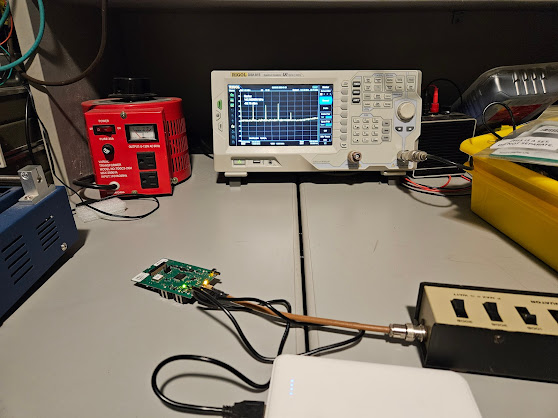Introduction
RS41ng on the DFM17 allows you to configure the output power via the RADIO_SI4063_TX_POWER setting in the config.h file. It allows values from 0-127. I set out to determine how that setting impacts the RF output power as well as the current draw from the batteries during transmission.
Testing configuration
I configured a DFM-17 with RS41ng. The DFM-17 has an SMA connector attached so that it could be wired through 19db of attenuators into a Spectrum Analyzer. Power was provided by a bench power supply. I varied the RADIO_SI4063_TX_POWER through various settings and measured both current draw and TX output power. The basic setup as as follows:
Bench power supply voltage: 7.5 volts
Bench power supply max current: 0.650 amps
Frequency: 432.605mhz
Modulation: Horus Binary V2
Testing
For each test, I reprogrammed the DFM-17 with a different RADIO_SI4063_TX_POWER setting and measured the output on the Spectrum Analyzer as well as the current draw on the bench power supply.
Example current draw when testing with the TX power set to 30:
Example Spectrum Analyzer result:
Results
| RADIO_SI4063_TX_POWER | DBM | Current (ma) |
|---|---|---|
| Idle Consumption | n/a |
65 |
| 1 | -12.0 | 76 |
| 12 | 3.0 | 90 |
| 25 | 9.0 |
107 |
| 30 | 10.4 |
112 |
| 45 | 14.0 |
128 |
| 50 |
14.7 |
132 |
| 75 | 17.8 |
151 |
| 100 |
18.8 |
162 |
| 127 |
19.2 |
182 |
Conclusions
For airborne use, 14dbm (25mW) has been observed to be sufficient for line of site reception of Horus Binary using other trackers. By setting RADIO_SI4063_TX_POWER set to 45, the power consumption is about 70% of transmitting at full power. The reduced power consuption would lead to longer battery life during flight, or on the ground during a HAB recovery.







